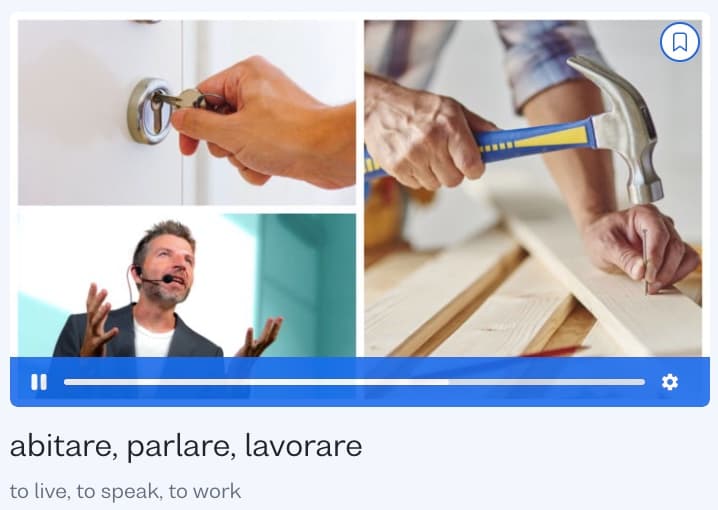I want to learn...
The present indicative or presente indicativo is the first tense you should learn in Italian. It’s very similar to the present tense in English, so the verb “to be” in this tense would look like “I am” or “she is.” We use the Italian present indicative for actions that are happening in the moment.
Read on to discover how to use this tense and learn the patterns for conjugating regular verbs, plus a few common irregular verbs you should know!
When to use the present indicative?
The Italian present indicative is used for actions or events that are:
Taking place at the time of speaking
Taking place on a regular basis or habitually. (E.g. I go to the store every Tuesday.)
Scheduled to happen in the future. (E.g. The meeting is tomorrow.)
Italian verbs are either regular or irregular. Today, we’ll begin by learning regular Italian verbs in the present tense.
Regular Italian verbs
Regular verbs follow a typical pattern of conjugation (that is, changing the verb to fit the subject). Once you memorize the pattern, you can apply it to hundreds of different Italian verbs—easier for us!
In Italian, each verb conjugates to each subject. There are seven Italian subject pronouns—io (I), tu (you), lui/lei (he/she), noi (we), voi (you plural) and loro (they) . Lui/lei take the same conjugation so that means there are six forms of every verb in the presente indicativo.
In Italian, there are three endings of verbs in their infinitive form: -are, -ere and -ire. Take off the last three letters of any verb, and that’s the verb stem.
The verb stem of cantare (to sing) is cant-
The verb stem of sentire (to hear, feel) is sent-
And so on. Once you have the verb stem, you can add the appropriate ending to the verb.
See the tables below for breakdowns of regular verb conjugations in the present tense. First, let’s start with the regular verb mangiare (to eat).
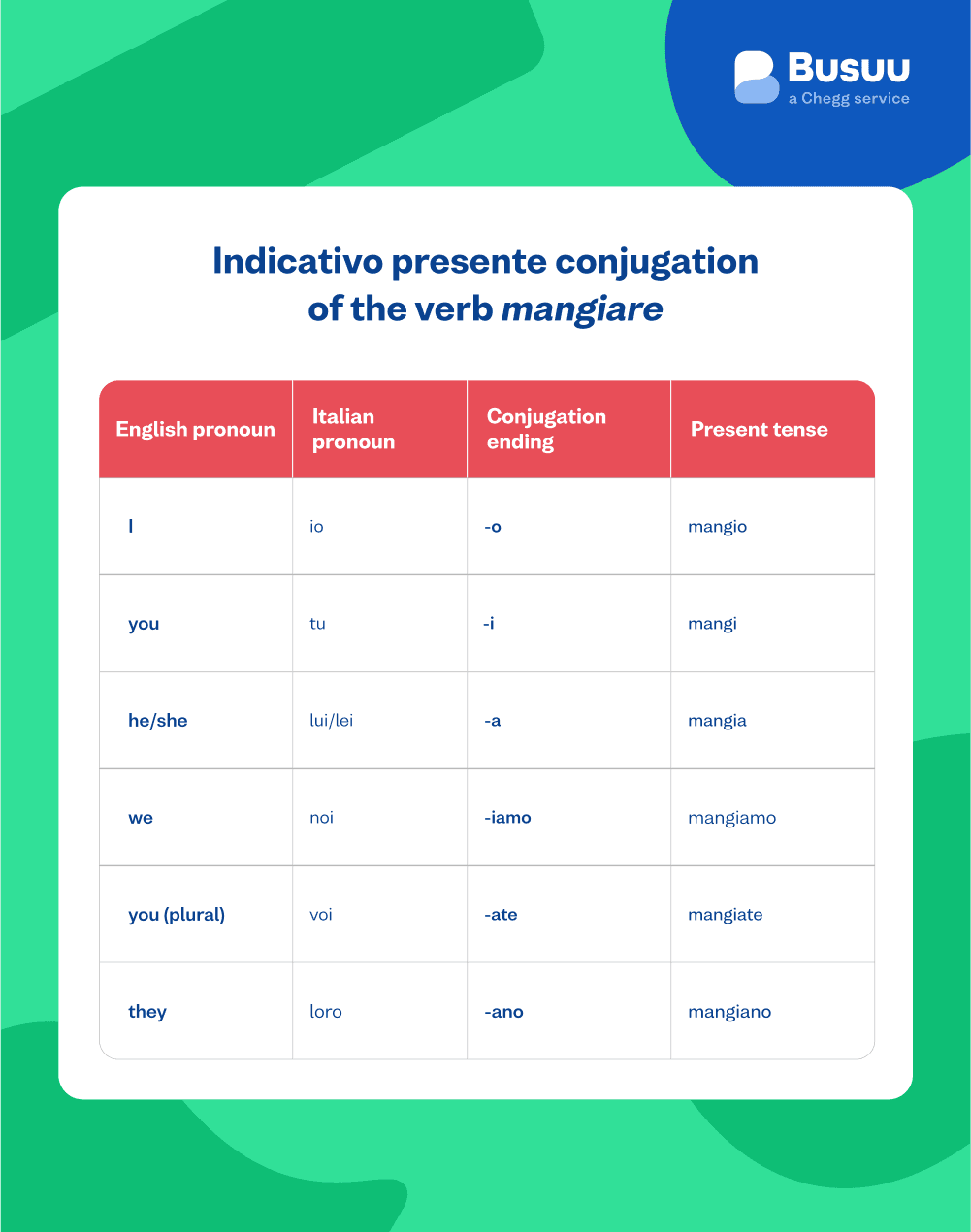
How to conjugate verbs ending in -are
| English pronoun | Italian pronoun | Conjugation ending | Present tense |
|---|---|---|---|
| I | io | -o | mangio |
| you | tu | -i | mangi |
| he/she | lui/lei | -a | mangia |
| we | noi | -iamo | mangiamo |
| you (plural) | voi | -ate | mangiate |
| they | loro | -ano | mangiano |
Take a look at some example sentences of the Italian present indicative, using gio care (to play…a sport):
Io gioco a calcio. (I play football.)
Giocate a calcio. (You all play football.)
Giocano a calcio. (They play football.)
Pro-tip: When there’s a verb stem ending in “c,” like gioc-, we will add an “h” any time there is an “i” immediately following it. We do this so the hard “c” sound is preserved—otherwise, in Italian, it would make a “ch” sound.
Here’s an example:
Giochi a calcio. (You play football.) ✓
Gioci a calcio. X
Giochiamo a calcio. (We play football.) ✓
Giociamo a calcio. X
As you might have noticed in the chart above, when a verb stem ends in “-i,” like mangi-, you don’t add an extra “i” in the second singular (you) or first plural (we) person.
Next up are verbs ending in-ere. An important verb that ends in -ere is vedere (to see). Take off the last three letters and the verb stem is ved-. Below is the table for each conjugation ofvedere:

How to conjugate verbs ending in -ere
| English pronoun | Italian pronoun | Conjugation ending | Present tense |
|---|---|---|---|
| I | io | -o | vedo |
| you | tu | -i | vedi |
| he/she | lui/lei | -e | vede |
| we | noi | -iamo | vediamo |
| you (plural) | voi | -ete | vedete |
| they | loro | -ono | vedono |
In bold, you can see the differences of -ere verbs from-are. Only the third person singular (he/she), third person plural (they) and the second person plural (you plural) will change.
How to conjugate verbs ending in-ire
Italian verbs ending in -ire are a little different because they have a couple of different ways they might look. For this ending, let’s see how this looks with two verbs: sentire (to feel, taste, hear, or smell) and capire (to understand).
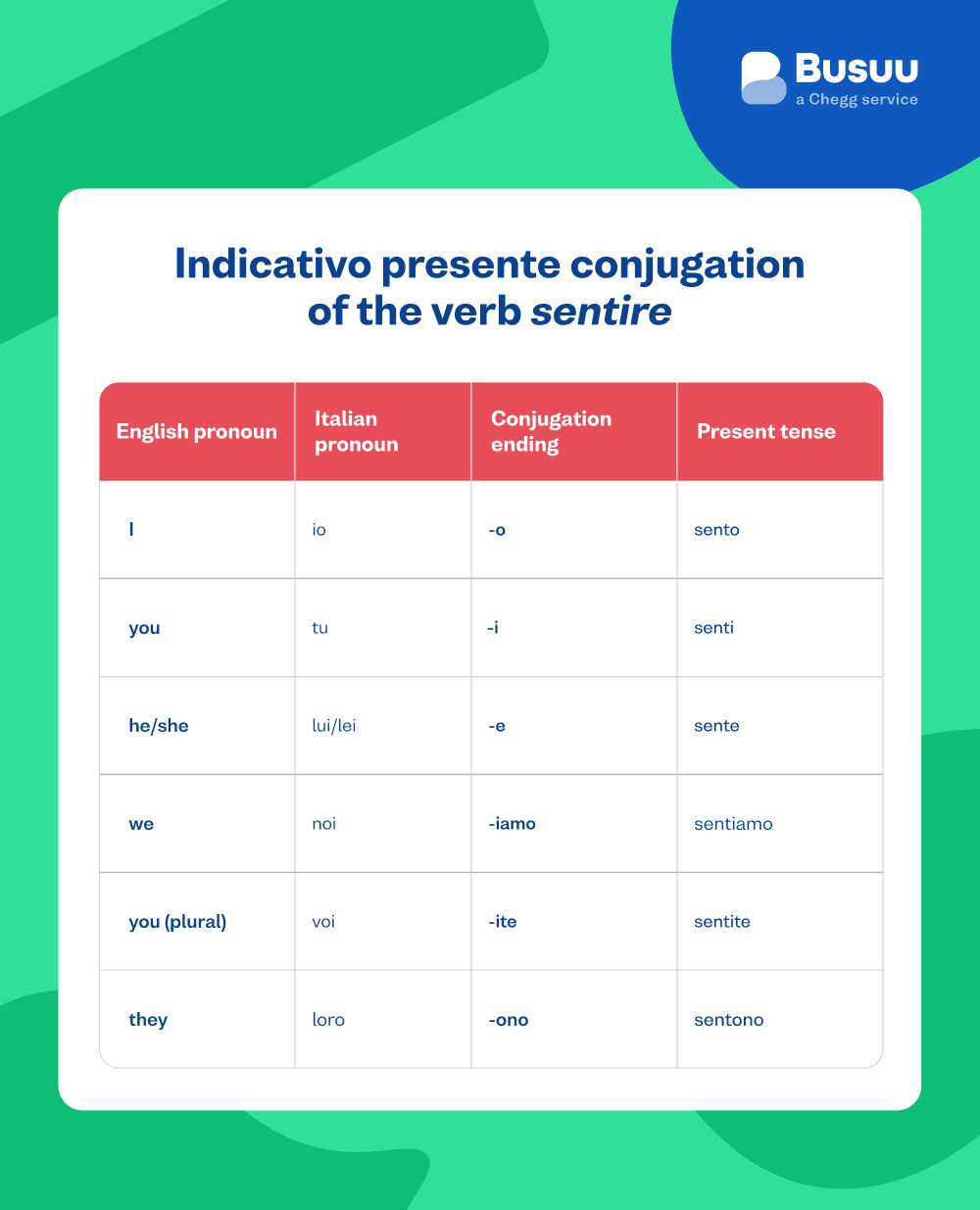
Sentire (first -ire ending)
| English pronoun | Italian pronoun | Conjugation ending | Present tense |
|---|---|---|---|
| I | io | -o | sento |
| you | tu | -i | senti |
| he/she | lui/lei | -e | sente |
| we | noi | -iamo | sentiamo |
| you (plural) | voi | -ite | sentite |
| they | loro | -ono | sentono |
Here, the only difference between -ere and -ire verb endings is in the second person plural (you plural). It changes from-ete into -ite.
These verbs will follow the same present tense pattern as sentire:
Aprire (to open)
Divertirsi (to have fun) – this is a reflexive verb.
Dormire (to sleep)
Offrire (to offer)
Partire (to leave)
Seguire (to follow)
Vestire (to dress)
But there’s another way to conjugate-ire verbs in the presente indicativo. Capire (to understand) in the present indicative looks a little different:

Capire (alternate -ire ending)
| English pronoun | Italian pronoun | Conjugation ending | Present tense |
|---|---|---|---|
| I | io -isco | capisco | |
| you | tu | -isci | capisci |
| he/she/it | lui/lei | -isce | capisce |
| we | noi | -iamo | capiamo |
| you (plural) | voi | -ite | capite |
| they | loro | -iscono | capiscono |
Other Italian verbs that follow this presente indicativo pattern:
Finire (to finish)
Costruire (to build, to construct)
Preferire (to prefer)
Pulire (to clean)
Spedire (to send)
Italian verbs that are irregular in the present indicative
Unfortunately, not all verbs follow an easy-to-remember pattern. Some verbs in Italian are irregular in the present tense, so the only way to begin using them is to memorize their pattern.
Here are the 12 most common Italian irregular verbs:
Potere (to can, to be able to)
Essere (to be)
Avere (to have)
Dovere (to have to, to must)
Piacere (to like)
Fare (to do, to make)
Volere (to want)
Dare (to give)
Bere (to drink)
Sapere (to know)
Stare (to stay)
Uscire (to go out)
Today’s lesson won’t go into the conjugation of each of these, but we will show you how to conjugate the two most important irregular verbs into the present indicative in Italian below.
Essere (to be) and avere (to have)
If there are any irregular verbs in the Italian present indicative you should learn first, it’s essere (to be) and avere (to have).
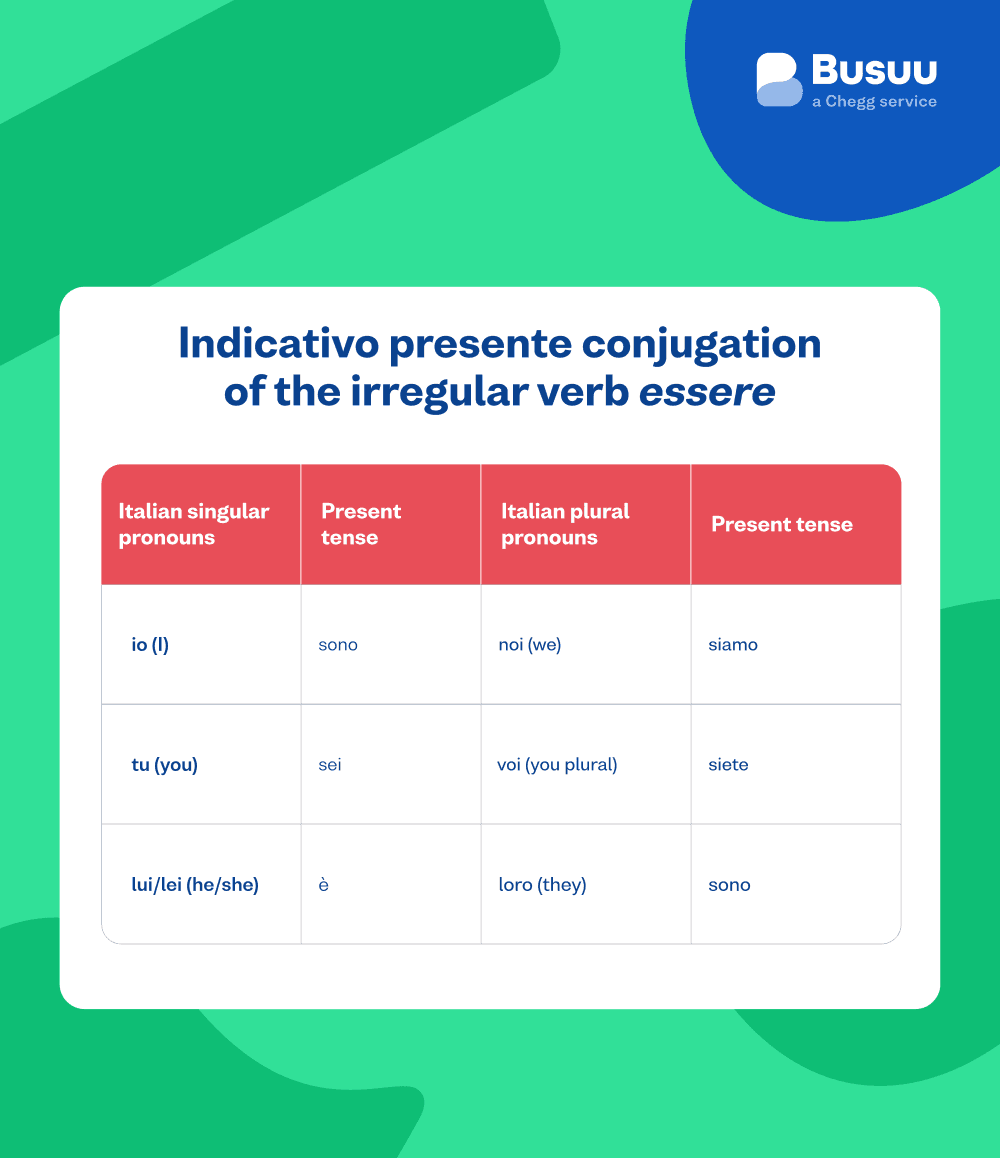
Essere (to be)
| Italian singular pronouns | Present tense | Italian plural pronouns | Present tense |
|---|---|---|---|
| io (I) | sono | noi (we) | siamo |
| tu (you) | sei | voi (you plural) | siete |
| lui/lei (he/she) | è | loro (they) | sono |
Examples of essere in the present indicative:
Sono una ragazza. (I’m a girl.)
Sei un vigile del fuoco? (Are you a firefighter?)
È difficile. (It’s difficult.)
Non sono americani. (They aren’t American.)
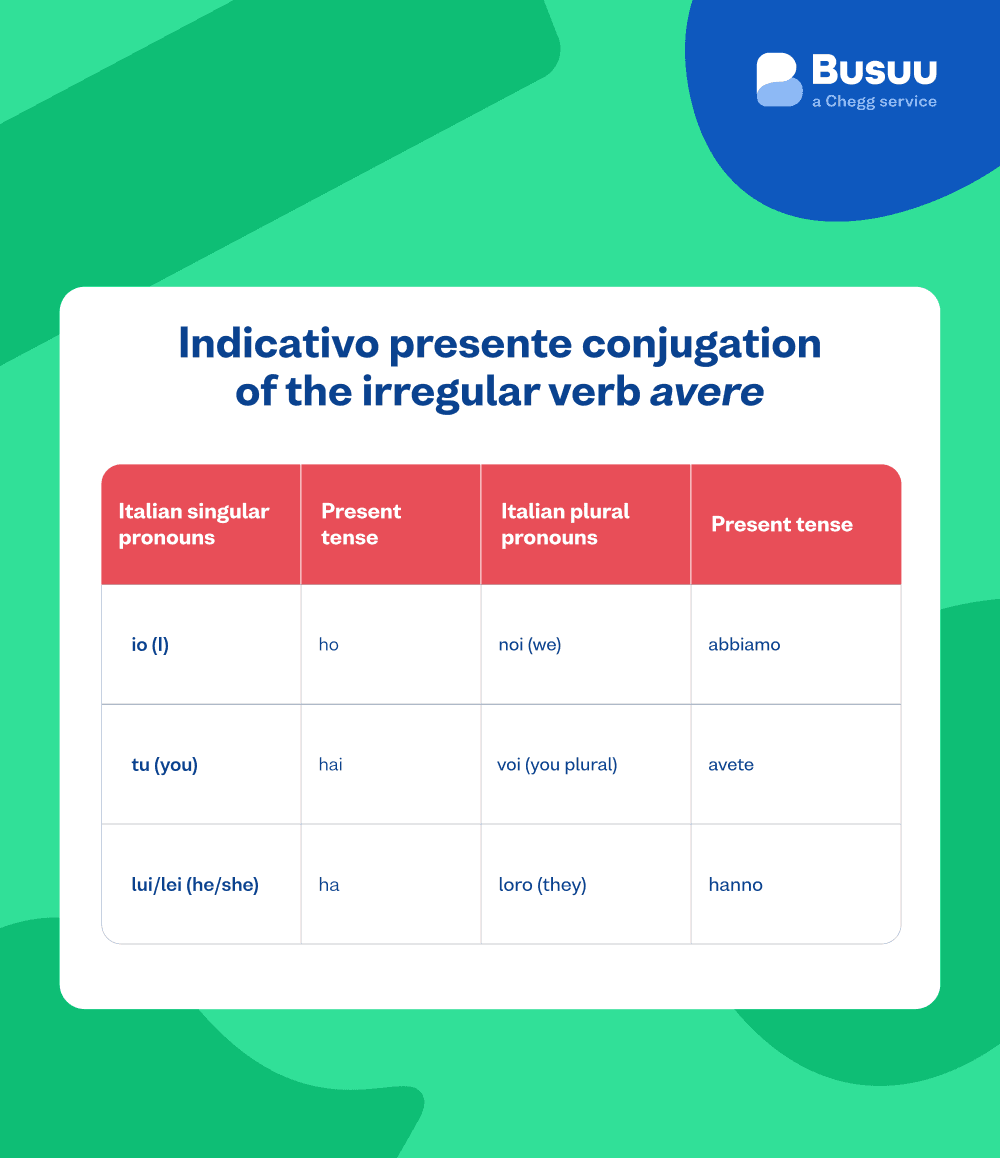
Avere (to have)
| Italian singular pronouns | Present tense | Italian plural pronouns | Present tense |
|---|---|---|---|
| io (I) | ho | noi (we) | abbiamo |
| tu (you) | hai | voi (you plural) | avete |
| lui/lei (he/she) | ha | loro (they) | hanno |
Examples of avere in the present indicative:
Ho freddo. (I’m cold.)
Ha 19 anni. (She/He’s 19 years old.)
Hanno un cane. (They have a dog.)
Avete compiti? (Do you have homework?)
Learning the presente indicativo tense requires some memorization, but it’s the most important tense to start learning Italian. Any time we want to talk about actions or events happening right now or on a regular basis, or even ones scheduled for the future, this is the tense to use.
Reinforce everything you learn today with lessons crafted by language experts. At Busuu, we help learners like you reach their language learning goals.
Newlanguages


